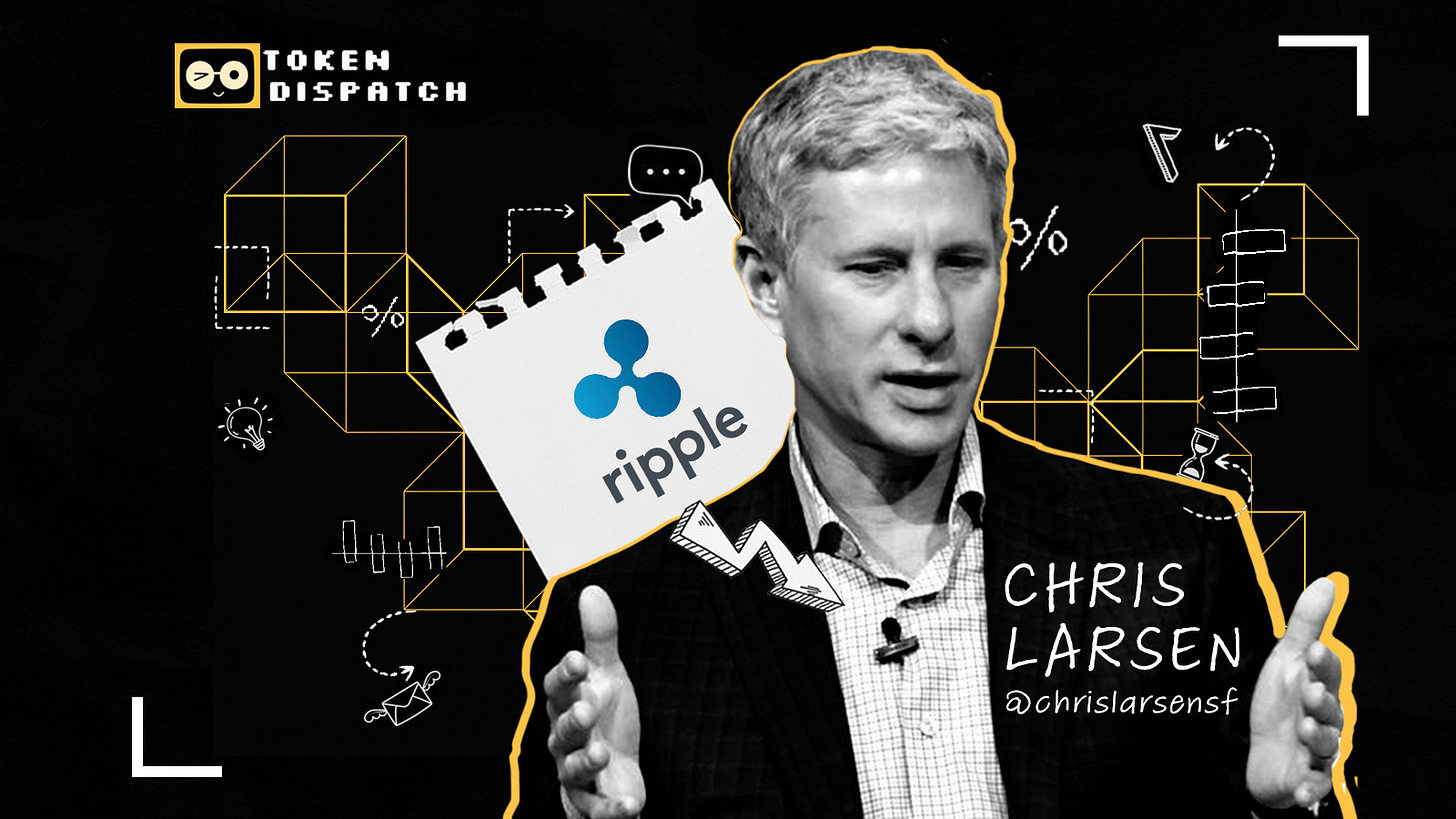Chris Larsen: Three Decades of Making Banks Slightly Less Terrible 💸
Ripple, international payments, regulatory arbitrage, and the curious case of making billions.
The check bounced.
At fifteen, Chris Larsen learned that getting paid was harder than doing the work.
He ran an auto dent repair business from their driveway in San Francisco. Neighbours brought him their banged-up cars, and he'd pound out the dents with borrowed tools and teenage determination.
The work was honest. The prices were fair. But when customers didn't pay, fifteen-year-old Larsen learned his first brutal lesson about how financial systems really worked.
His father fixed aircraft engines at SFO for steady wages that arrived every two weeks. His mother drew illustrations for clients who sometimes paid months late, if at all. Both parents understood that money flowed easily to people who already had it, and grudgingly to everyone else.
The system was designed to work this way.
That frustration simmered for decades, driving him to build three companies worth billions of dollars. Each one attacked a different piece of the financial establishment that treated ordinary people like inconveniences rather than customers.
That’s exactly what you need to read on a Monday.
The Biggest Web3 × AI Gathering in India is Here
Metamorphosis 2024 brings together 1,000+ attendees, 75% C-level executives, and 50+ visionary speakers for two days of learning, networking, and dealmaking.
Here’s what to expect:
25+ panel discussions with thought leaders in crypto, AI, and enterprise tech
Exclusive access to top decision-makers driving innovation across industries
Festival vibes with curated networking spaces, lounges, and breakout sessions
📍 Le Meridien, Gurgaon | Sept 27–28
🎟 Special for TTD readers: 20% OFF tickets with code TTD20
The Mechanic's Son Who Saw Through the System
1960. San Francisco.
Chris Larsen was born to parents who understood the value of steady work. Growing up in a working-class family meant experiencing the financial system from the customer side rather than the banking side. When his parents needed a car loan or mortgage, they dealt with bank officers who made decisions behind closed doors. The process was opaque, slow, and often unfair.
Why did some people have easy access to loans while others didn't? Why did banks charge different rates to different customers for identical services? Why did everything take so long when the actual decisions could be made in minutes?
These were personal frustrations that millions of families faced but few people in positions to change anything had experienced firsthand.
After high school, Larsen started studying aeronautics at San Jose State, following a practical path that might lead to steady engineering work. But the courses felt too narrow. He transferred to San Francisco State University, switching to international business and accounting.
After graduating in 1984, Larsen joined Chevron as a financial auditor. The job took him to Brazil, Ecuador, and Indonesia. This experience with global business operations provided him with firsthand knowledge of how international financial systems worked.
But he needed to understand the system better before he could change it.
In 1991, Larsen earned his MBA from Stanford Graduate School of Business. His professor Jim Collins taught him about building companies that could outlast their founders. The lessons stuck. Larsen wasn't interested in quick wins or trendy business models. He wanted to build infrastructure that would still matter decades later.
The Internet Meets Finance
1996. The dot-com boom was just beginning.
While most entrepreneurs were building websites for pet supplies or grocery delivery, Larsen saw a different opportunity. What if you could apply the internet to the most traditional industry of all: mortgages?
He co-founded E-Loan with Janina Pawlowski.
The concept? Put mortgage applications online so borrowers could shop for loans without dealing with brokers who added unnecessary fees.
Most financial institutions were still operating like it was 1976, not 1996. They required borrowers to visit branch offices, fill out paper forms, and wait weeks for approval decisions that could be made in minutes with the right software.
E-Loan's website launched in 1997, allowing borrowers to compare rates, submit applications, and track their progress online. The company eliminated broker commissions and reduced processing time from weeks to days.
But Larsen made a decision. E-Loan became the first company to provide consumers with free access to their FICO credit scores.
This was revolutionary. Banks and credit card companies had been using these scores for decades to make lending decisions, but consumers couldn't see their own numbers. The credit scoring system was a black box that determined whether you could buy a house or car, but you had no idea what was inside it. The move pressured the entire credit industry toward transparency. If borrowers could see their scores, they could understand why they were being offered certain rates and take steps to improve their creditworthiness.
E-Loan went public in 1999 during the height of the dot-com boom. At its peak, the company was valued at around $1 billion. But Larsen wasn't interested in riding bubbles. In 2005, he sold E-Loan to Banco Popular for $300 million.
E-Loan had succeeded because it automated processes that banks were doing manually. But not reimagine how they could work entirely?
Cutting Out the Banks
2005. Larsen was already thinking about his next target: the banks themselves.
What if ordinary people could lend money directly to other ordinary people, cutting banks out of the equation entirely?
He co-founded Prosper Marketplace with John Witchel. The first peer-to-peer lending marketplace in the United States.
The concept? Borrowers could post loan requests explaining what they needed money for and what interest rate they were willing to pay. Individual lenders could browse these requests and choose which loans to fund. The market would determine interest rates based on actual supply and demand rather than opaque bank formulas.
The platform democratised both sides of lending. People with good credit could earn better returns than they got from savings accounts. People with less-than-perfect credit could access loans that traditional banks wouldn't offer.
But Prosper faced a problem E-Loan hadn't encountered: regulatory uncertainty. Securities laws had been written decades before anyone imagined ordinary people lending money to strangers over the internet. In 2008, the SEC ruled that peer-to-peer loans were actually securities that required registration and disclosure. Many companies would have fought the regulators or tried to find loopholes. Larsen chose a different path.
Rather than fight the authorities, he worked with them. Prosper filed a prospectus with the SEC and changed its business model to comply with securities laws. The company survived the regulatory challenge and continued growing.
Because, you can't just build better technology. You have to help regulators understand why new rules might be necessary.
In 2012, Larsen stepped down as CEO of Prosper but remained chairman. He was already thinking about his next venture. Peer-to-peer lending had shown him that technology could disintermediate traditional finance. But the really ambitious target wasn't domestic lending.
It was international payments.
Building the Internet of Value
The idea that would become Ripple started with a simple observation: sending money across borders was still harder than sending an email.
International wire transfers took days, cost substantial fees, and often failed for mysterious reasons. In an era when information could travel around the world in milliseconds, moving money felt stuck in the 1970s.
September 2012. Larsen co-founded OpenCoin with programmer Jed McCaleb. Their goal was to build a payment protocol that could settle transactions between any currencies in seconds rather than days. The company went through several name changes and OpenCoin became Ripple Labs in 2013, then simply Ripple in 2015. But the mission remained constant: create what Larsen called "the Internet of Value."
Ripple's approach was different from Bitcoin, which was designed as an alternative to traditional currencies. Instead, Ripple built technology that could make traditional currencies move more efficiently. Banks could use Ripple's network to settle international payments without maintaining accounts in every country where they did business. The system used XRP, Ripple's native digital currency, as a bridge asset.
Instead of converting dollars to euros through multiple intermediaries, a bank could convert dollars to XRP, transfer the XRP to another bank, and have that bank convert XRP to euros. The entire process could happen in seconds.
Under Larsen's leadership as CEO, Ripple signed partnerships with major financial institutions including Santander, American Express, and Standard Chartered. You can call them pilot programs or experiments. But banks were using Ripple's technology to process real customer payments worth millions of dollars.
As cryptocurrency markets exploded in 2017 and 2018, XRP became one of the most valuable digital assets in the world. At its peak, Larsen's holdings were worth over $59 billion on paper, briefly making him one of the wealthiest people in America.
But Larsen had learned from his previous companies that scaling required different skills than founding. In 2016, he stepped down as CEO and became executive chairman, bringing in Brad Garlinghouse to handle day-to-day operations while he focused on strategy and regulatory relationships.
Read: Brad Garlinghouse: The Power Broker ✊
Success was about to bring scrutiny.
The Regulatory Crucible
December 2020. The phone call every crypto executive dreads.
The Securities and Exchange Commission was suing Ripple, alleging that XRP was an unregistered security and that the company had raised $1.3 billion through illegal securities offerings.
The lawsuit created uncertainty that would last nearly five years. XRP's price fell as exchanges delisted the token to avoid regulatory risk. Ripple faced the possibility of massive fines and fundamental changes to its business model.
Larsen could have settled quickly and moved on to other projects. Many crypto entrepreneurs would have. Instead, he chose to fight.
Ripple spent tens of millions of dollars on legal fees, arguing that XRP functioned as a currency rather than a security. The company's lawyers pointed out that Bitcoin and Ethereum had been declared non-securities by regulators, and XRP operated similarly.
The strategy proved correct, but it took years to vindicate.
In 2023, Judge Analisa Torres ruled that programmatic sales of XRP to retail investors did not constitute securities offerings. The decision was a partial victory that helped clarify the regulatory status of digital assets.
In 2025, the SEC dismissed its appeals and settled the case for $125 million which a substantial fine, but a fraction of what many had expected. The legal victory validated Larsen's long-term approach to building crypto companies.
Rather than operating in regulatory gray areas like many crypto firms, Ripple had worked with authorities from the beginning. When the crackdown came, the company was prepared.
Throughout the legal battle, Ripple continued expanding its business. In April 2025, the company acquired prime brokerage firm Hidden Road for $1.25 billion, adding trading and custody services to its portfolio. Ripple is also pursuing a national bank charter and has partnered with BNY Mellon to custody reserves for its RLUSD stablecoin.
The Quiet Impact
Today, Larsen's influence extends far beyond the companies he's built.
In 2019, he and his wife Lyna Lam donated $25 million in XRP to San Francisco State University which is the largest cryptocurrency gift to a US university at the time. The donation created endowed chairs in fintech and innovation while funding global programs for students. Universities have rigorous processes for accepting and managing donations. By working through these institutions, Larsen helped normalise crypto philanthropy.
He's also funded privacy advocacy through Californians for Privacy Now, a coalition that successfully pushed California to pass financial privacy laws requiring companies to get consumer permission before sharing personal data. The campaign collected 600,000 signatures and lobbied major financial firms to withdraw their opposition.
More recently, Larsen has become vocal about cryptocurrency's environmental impact. In 2021, he launched the "Change the Code, Not the Climate" campaign, funding efforts to convince Bitcoin miners to switch from energy-intensive proof-of-work mining to more efficient alternatives.
The position put him at odds with Bitcoin maximalists who view proof-of-work as essential to the network's security. But Larsen argued that cryptocurrency needed to address climate concerns if it wanted mainstream adoption.
“This campaign is not anti-Bitcoin – it is anti-pollution,” explained Larsen, “We need to clean up our industry. And the issue is not, as some have suggested, powering Bitcoin with clean energy. We need the limited supply of clean energy for other vital uses. The issue is changing the code to use far less energy. That’s the environmentally responsible way forward.”
His willingness to challenge crypto orthodoxy reflected the same thinking that had driven his business career: popular doesn't always mean optimal.
At 64, Larsen continues working six days a week while pursuing hobbies that reflect his methodical approach to complex problems. He restores classic cars from the 1960s with his sons, taking them apart and rebuilding them from the frame up. The projects take three years to complete and require the same attention to detail that has characterised his business career.
He envisions a world where sending $100 from San Francisco to Lagos takes seconds and costs pennies, where small businesses can access international markets without navigating complex banking relationships.
His three companies attacked different pieces of the financial system that weren't serving ordinary people well enough.
E-Loan made mortgage shopping transparent. Prosper democratised lending. Ripple accelerated international payments.
Each venture succeeded by building infrastructure that others could use rather than trying to control entire markets. The approach requires patience and long-term thinking, qualities that are rare in an industry known for hype and quick profits.
At a time when crypto is often associated with speculation and volatility, Larsen has proven that patient infrastructure building can create lasting change. His work isn't finished, but the foundation is in place for a financial system that serves users rather than institutions.
Money is becoming more like information — faster, cheaper, and more accessible to people who were previously excluded from financial services.
That transformation is still unfolding, but the direction is clear. And Chris Larsen has been building the rails that will carry it forward.
That’s it about the Chris Larsen. Will come to you with another profile next week.
Until then …stay curious.
Token Dispatch is a daily crypto newsletter handpicked and crafted with love by human bots. If you want to reach out to 200,000+ subscriber community of the Token Dispatch, you can explore the partnership opportunities with us 🙌
📩 Fill out this form to submit your details and book a meeting with us directly.
Disclaimer: This newsletter contains analysis and opinions of the author. Content is for informational purposes only, not financial advice. Trading crypto involves substantial risk - your capital is at risk. Do your own research.







